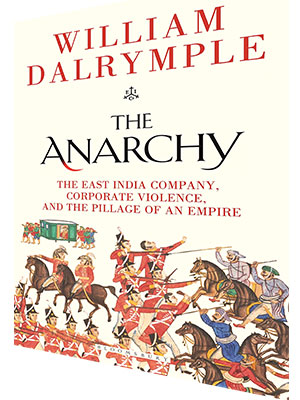 The Anarchy: The relentless rise of the East India Company – William Dalrymple
The Anarchy: The relentless rise of the East India Company – William Dalrymple
Bloomsbury; Rs.511; Pages 397
If there is a deep antagonism to capitalism within the collective psyche of Indians, it can be traced back to the corporate excess, exploitation and pillage of this landmass by the London-based East India Company (EIC) — undoubtedly the most powerful multinational in world history — in the last and fading years of the Mughal Empire. The rise of EIC, which received a wide-ranging royal charter from Queen Elizabeth I for “trade to the East Indies” on December 31, 1600, into the mightiest corporation in global history that in its heyday commanded an army of 200,000 men and ruled over 300 million Indians — “a state in the guise of a merchant”— is brilliantly recounted in this page-turning historical narrative.
It reads like a novel, and is certain to prompt right-thinking citizens towards the conclusion that we have not learned sufficient lessons from the mercenary and mendacious rule of the EIC and its successor, the British Crown. They ruled for almost 200 years over India which until the 18th century was the world’s richest and most prosperous region after imperial China.
It’s important to note that the British arrived in India not as marauding conquerors but as humble petitioners anxious to trade with Mughal India “which was producing about a quarter of global manufacturing… and in many ways was the world’s industrial powerhouse and the world’s leader in manufactured textiles,” writes William Dalrymple, the widely read Indophile author who has written over a dozen deeply-researched historical narratives of Mughal India: White Mughals (2002), The Last Mughal (2006), Nine Lives: In Search of the Sacred in Modern India (2009), City of Djinns (1993) among other tomes. The merchants of EIC came to India merely to trade in commodities — fine muslin, silk, indigo and spices — load their ships and sell these luxuries back home profitably.
The first “man of quality” sent by King James I of England to petition Emperor Jehangir for grant of a trading licence to the company was Sir Thomas Roe who arrived in India in 1615, but was given short shrift by the great Mughal. Nevertheless, Roe stuck around for three years living in slummy conditions before he was given permission to build a factory in Surat, Gujarat. That was the start of a Mughal-EIC relationship during which the Brits learned to do business in India. “Over the next 200 years, it (the company) would slowly learn to operate skilfully within the Mughal system, and do so in the Mughal idiom, with its officials learning good Persian, correct court etiquette, the art of bribing the right official and in time out-manoeuvring all their rivals — Portugese, Dutch and French — for imperial favour,” writes Dalrymple.
Although in recent times several well-researched and anguished accounts of British atrocities in the Indian subcontinent have been written — notably An Era of Darkness by politician-writer Shashi Tharoor — it’s also important to bear in mind that the keys of princedoms and principalities of 18th century India were virtually presented to the Brits by greedy satraps of the Mughal emperor in Delhi. After the death of Emperor Aurangzeb in 1707, who drained the imperial treasury by conducting incessant sectarian wars in the Deccan and against the Marathas in the west, the Mughal empire fragmented, and went into terminal decline.
The fault that a bunch of ruddy traders who after much importuning were allowed to construct factories — essentially warehouses in Surat, Masualipatnam, Patna and Calcutta through the 17th century — were able to take over the whole country, lay not in the stars of the later much-abused natives, but in their foolish, greedy and fractious rulers. And by way of context it’s also pertinent to note that in Europe, the Dutch, Portugese and French had simultaneously built large and durable merchant ships to facilitate and accelerate trade in spices, textiles, gems and jewellery with Asia, and were not averse to extending their European wars and conflicts to India. Therefore with the passage of time, their trading factories were transformed into forts to protect their merchandise from foreign and indigenous predators (Rohilla Afghans, bandits and pirates).
Even as the competing Europeans transformed their factories into forts, after the death of Aurangzeb wars of succession broke out and three emperors were murdered in quick succession while the armies of Maratha chieftains looted the country right up to the gates of Delhi. Governors appointed by Mughal emperors in various parts of the subcontinent, notably Bengal, and Golconda and Mysore in the south became increasingly autonomous and stopped sending tax revenues to Delhi. As a result, the Mughal emperor in Delhi who had once commanded an army of 4 million men couldn’t afford an army, which cleared the way for Rohilla Afghan warlord Ahmed Shah Durrani to conduct 17 annual raids to plunder North India and Delhi, and cart away the Kohinoor diamond and Peacock throne to Afghanistan.
In short, as the title of Darlymple’s engrossing volume trumpets, the 18th century was a period in which a great anarchy was let loose on the land, to the extent that businessmen and traders who couldn’t go about their daily business welcomed the EIC, whose representatives brought a degree of law and order and had some idea of how to maintain it.
The beginning of British rule over India, which was to last for almost two centuries, can be traced back to the objection of 25-year-old Siraj ud-Daula, Nawab of Bengal, to the EIC fortifying its Fort William factory in Calcutta following reports of a French flotilla sailing to attack it. Angered by this defensive action which was in direct contravention of the terms and conditions of the company’s licence to trade, Siraj ud-Daula captured the fort which resulted in the infamous Black Hole of Calcutta incident, when several British prisoners died from asphyxiation.
This led to the historic Battle of Plassey (1757), in which EIC adventurer governor Robert Clive treacherously turned the nawab’s general Mir Jafar against him through naked bribery, and routed Siraj ud-Daula with a mere 3,000 men. The Battle of Plassey much glorified in British history — and in the author’s opinion the even more decisive Battle of Buxar (1764) in which the “provincial Mughal elite” led by Mir Qasim (Mir Jafar’s son-in-law) made a last unsuccessful stand — won the company control and diwani of Bengal, marking the beginning of EIC rule, which was to last for a century, after which the British Crown took over and completely beggared the world’s richest region.
The Anarchy is a compelling account of the British Raj written with great verve and detail about the intrigues of the Mughal court in Delhi, and in the palaces of the nawabs and rajas who ruled the large and small kingdoms which were doing their own thing following the steady erosion of the Mughal empire in the 18th century.
The main lesson to be learned from this insightful history of the EIC, is that rulers, including latter-day politicians, should never under-estimate the power of businessmen, especially bankers. These are constituencies with the greatest interest in maintenance of law and order.
As Dalrymple depicts in fascinating detail, many of the nawabs and rajas of 17th and 18th century India were dissolute despots who ruled by whim and fancy. On the other hand, to smooth the flow of commerce in its forts and enclaves, the company, and later the Crown accorded high priority to the maintenance of public order, and established courts for governing according to the tried and tested precepts and practices of Common Law.
In particular under the directions of head office, the company’s governors and administrators accorded great respect to the Jagat Seths, powerful indigenous bankers who preferred to lend to the Brits with a tradition of honouring contracts and paying timely interest. This enabled the company to pay its mercenary and native forces regular wages. On the other hand, undisciplined native rulers seldom paid their debts or soldiers on time, prompting many of them to resort to banditry and/or desert to the company.
Unfortunately, post-independence India’s rulers down to this day have not learned these elementary principles of good governance. Seventy years after independence, contemporary India resembles the anarchy that was let loose after Aurangzeb’s death. That’s the implicit warning embedded in this knowledgeable and engaging study of the rise of the East India Company and the fall into an abyss of poverty and misery of the once flourishing subcontinent under company and crown rule.
Dilip Thakore




























